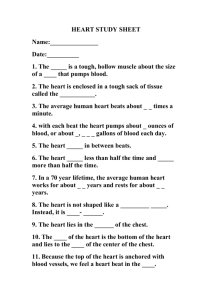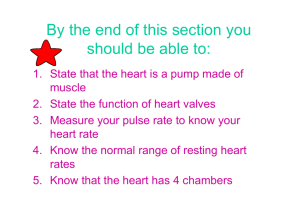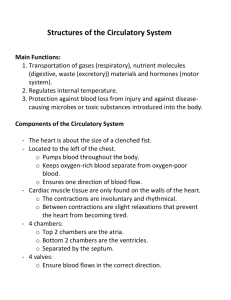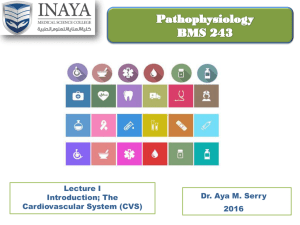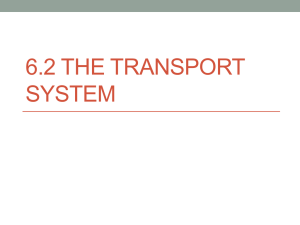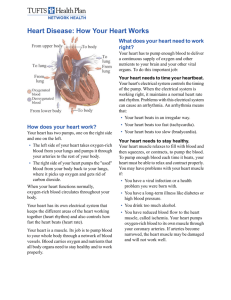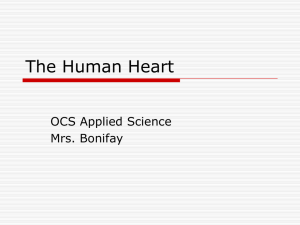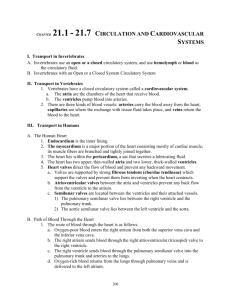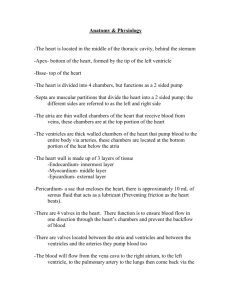SNC2D Circulatory System
advertisement
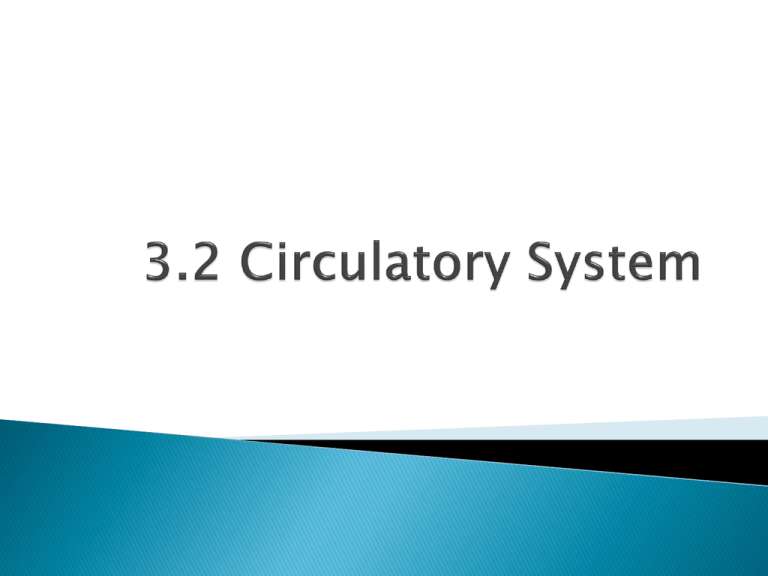
- Moves oxygen from the lungs to all the body cells Moves carbon dioxide from the body cells to the lungs Moves nutrients from the small intestine to the body cells Moves waste materials from the body cells to the kidneys and skin Regulates the body temperature and transports disease-fighting white blood cells to sites of viruses or bacteria Heart – the pump Blood – the fluid in which materials are transported Blood Vessels – the tubes to carry the blood Blood is a type of connective tissue that circulates through your body, it consists of 4 parts: ◦ Red Blood Cells (RBC) – (oxygencarrying cells) - 45% of the blood’s volume - contains a protein called hemoglobin (carries the oxygen) - makes the cells appear red Did you know… - It takes about 20 seconds for a RBC to circulate the entire body ◦ White Blood Cells (WBC) – (infection-fighting cells) -less than 1% of the volume of blood -the only blood cell with a nucleus ◦ Platelets – (blood clotting cells) -less than 1% of the blood ◦ Plasma – (protein-rich liquid) -about 55% of blood’s volume - - There are 3 types of blood vessels: Arteries carry oxygenated blood away. Arteries are thicker than the other vessels Veins carry deoxygenated blood toward the heart. Blood is at lower pressure – walls are not as thick - Capillaries is where the gas exchange occurs. They are very thin & narrow. O2 diffuses from the blood to the surrounding tissues and CO2 and other wastes pass from the body to the blood to be carried out for disposal. composed of: cardiac muscle tissue, nerve tissue, connective tissue and epithelial tissue cardiac muscle tissue undergoes contractions & conducts electrical impulses frequency of heart beat (heart rate) depends on your physical activity level and other factors (stress, general health, etc). Regulated by nerve tissue. Did you know… ◦ Your circulatory system is about 95,000 km long ◦ Your heart beats more than 2.5 billion times in the average lifetime ◦ the human heart creates enough pressure when it pumps to squirt blood 30 feet. muscles & nerves are covered by a smooth layer of epithelial tissue reduces friction & protects the heart from damage when the lungs expand and contract. inner surface is lined with epithelial tissue to allow the blood to flow freely. Did you know… ◦ Your circulatory system is about 95,000 km long ◦ Your heart beats more than 2.5 billion times in the average lifetime ◦ the human heart creates enough pressure when it pumps to squirt blood 30 feet. Path of Blood in the Heart •blood is collected in the atria (plural of atrium) via veins •atria walls contract, blood is pumped from the atria to the ventricles via opened atrio-ventricular (AV) valves •semi-lunar valves are closed to prevent blood from flowing to arteries while the ventricle fills up with blood •ventricle walls contract, causing rise in blood pressure Path of Blood in the Heart •high blood pressure cause AV valves to close to prevent back flow of blood to atria •high blood pressure also cause semi-lunar valves to open to allow blood to be pumped from ventricles to arteries •as blood leaves ventricles, pressure inside the ventricles drop and ventricles stop contracting •the semi-lunar valves close to prevent back flow of blood from arteries to ventricles Coronary Artery Disease (CAD) Coronary arteries provide blood to the heart muscle tissue itself Can be blocked with plaque – a deposit of fat, cholesterol, calcium, etc. Plaque buildup can be caused by inherited genetic information, poor lifestyle choices, i.e. high-fat diet, smoking, lack of exercise. Symptoms – tiredness, dizziness, pain or a burning in chest & arms can be diagnosed with the aid of an angiogram (X-ray), a fluorescent dye is injected into the bloodstream Heart Attack Coronary arteries become blocked by plaque or a blood clot Heart muscle cells no longer receive the O2 or nutrients Heart stops pumping, heart tissue dies Symptoms: chest pain or pressure, shortness of breath, nausea, anxiety, upper body pain, abdominal or stomach pain, sweating, dizziness, unusual fatigue Requires immediate medical attention Can be diagnosed with a blood test (looks for certain proteins that are only present when cardiac muscle dies) and an electrocardiogram, ECG (measures the electrical signals created by the heart as it beats) Read pg. 100 - 103 “Circulatory System Package”
